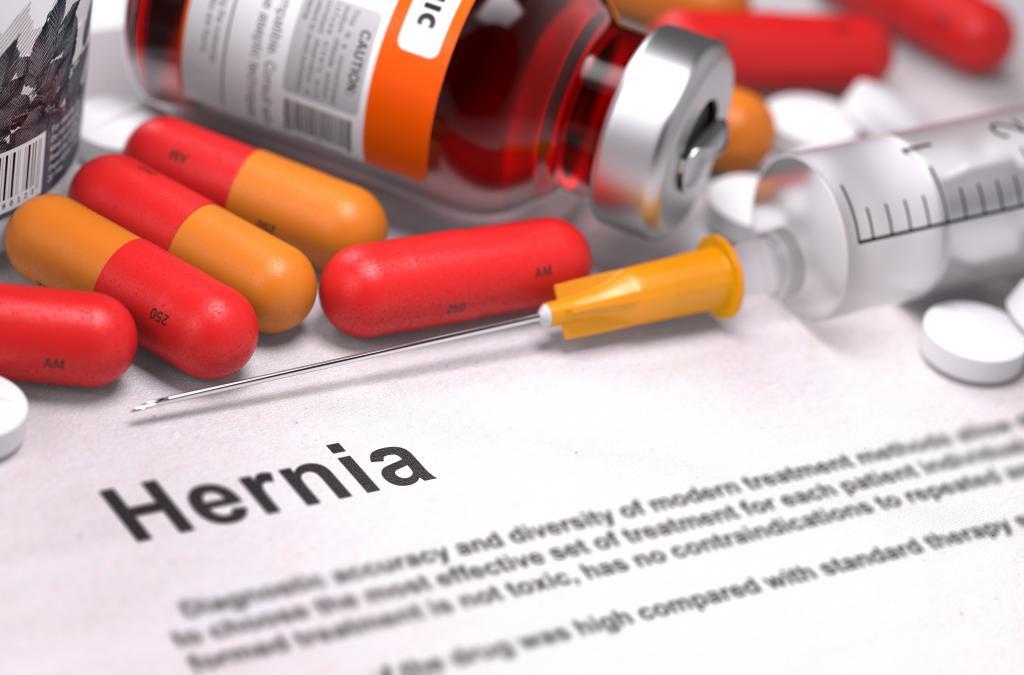
Hernias are bulges or tears in the abdominal muscle. They occur when the inside layer of the abdominal wall becomes weak. A small, balloon-like sack can form and a loop of intestine or abdominal tissue may push into the sac, causing pain. In some cases, hernias can be so serious, they require emergency surgery. No matter the degree, a hernia will usually not heal on its own and frequently results in some type of surgery.
The 5 Common Types of Herniation
Ventral Hernia
Ventral hernias occur when a section of the intestine protrudes through a weak spot in the abdominal wall. Weak spots can be the result of a tear, hole, or abnormality in the wall and can affect both men and women. If the weakness is due to an incision made during a prior surgery, the condition is referred to as an incisional herniation.
Incisional Hernia
After abdominal surgery, incision site(s) are indefinitely weakened, even after completely healed. That’s because the original muscle and tissue is replaced with scar tissue that can thin over time. Incisional hernias occur in these areas because the abdominal wall can be pushed through. Incisional hernias occur after 2 to 10 percent of all abdominal surgeries.
Umbilical Hernia
The point at which the umbilical cord connected to the abdomen is inherently weak and susceptible to herniation. Umbilical hernias most commonly occur in infants and babies under 6 months old, and are observed in about 15 to 20 percent of all babies born in the USA. They manifest near the belly button and (contrary to the above-mentioned) are the only type that may go away on their own. If the hernia doesn’t resolve itself by the time the child is two years old, surgery may be performed to correct the issue.
Adults may also develop umbilical hernias, usually because of injury or unusual weakness of the abdominal wall.
Hiatal Hernia
Hiatal hernias result when part of your stomach pushes up into your chest through your diaphragm (a wall of muscle that contracts to aid in breathing and separates organs in your chest from the rest of your body). More common in patients over the age of 50, hiatal hernias will likely cause acid reflux.
Inguinal Hernia
About 70 percent of all hernias are inguinal, which occur when the intestines breach a weak spot or tear in the lower abdominal wall (usually within the inguinal canal, located in the groin area). Inguinal hernias are more common in men because, shortly after birth, the testicles drop down through the inguinal canal. The canal should fully close behind them, but in some cases, it doesn’t. This creates a weak spot susceptible to herniation. About 25 percent of men and 2 percent of women will develop an inguinal hernia in their lifetime.
Common Causes
In most cases of childhood herniation, the culprit is congenital. Children are born predisposed to a hernia, and the condition may or may not resolve itself as the body grows. In adults, the cause is usually abdominal weakness paired with some degree of muscle straining. But several factors can contribute to the development of a hernia:
Smoking: Incisional, inguinal and recurrent inguinal hernias are more common in smokers than non-smokers for two reasons. First, smoking creates wound complications and prevents connective tissue from healing well. Second, smoking leads to laborious coughing, which can create excessive pressure on the lower abdomen. A 2005 study revealed that smokers are 4x more at risk for developing an incisional hernia.
Obesity: Obesity can contribute to the development of abdominal wall hernias, including inguinal, ventral and incisional, because carrying excess weight places strain and pressure on the lower abdomen.
Poor Nutrition: Poor nutrition is often a contributor to the development or painful symptoms of a hiatal hernia, but it can also cause obesity or excessive weight loss and malnutrition, which causes weak muscles and can contribute to abdominal wall hernias. Individuals with a hiatal hernia should avoid large meals that cause a spike in the body’s production of acid, as well as foods rich in fat.
If you have a hiatal hernia, or suffer from acid reflux, steer clear of:
- Citrus
- Chocolate
- Fried foods
- Garlic/onion
- Spicy food
- Peppermint and spearmint
- Tomato
- Coffee/alcohol
- Carbonated drinks
- Dairy
- Oil/butter
To prevent the development of a hernia and maintain healthy weight, eat more:
- Fruits: especially bananas and apples
- Vegetables: especially green beans, peas, carrots and broccoli
- Whole grains
- Low-fat, fat free or skim dairy
- Lean meats
- Healthy fats in moderation, such as: nut butters, coconut oil, avocado
Respiratory Issues:
Respiratory issues such as pulmonary disease or cystic fibrosis can also contribute to the development of a hernia. Pulmonary disease is any condition that impacts the blood vessels between the lungs and heart. Cystic fibrosis is a hereditary disorder of the exocrine glands wherein, excessive mucus is produced. In both cases, chronic coughing, wheezing and shortness of breath can result, which creates unnecessary pressure on the abdomen.
Straining or Poor Lifting Technique:
Constipation, an enlarged prostate (that causes you to strain while urinating) poor lifting technique and/or sudden movement can cause any of the above hernia types to manifest. A high fiber diet will soften the stool and reduce straining during bowel movement. When lifting, you should always keep a wide base, squat down, lift with the legs and maintain good posture. Use a back brace to help take excessive pressure off your abdomen and hold the load close to your body to reduce strain.
Pregnancy may also contribute to the development of a hernia, as weight gain and fetal growth will place excess pressure on the abdomen.
Race:
Surprisingly, umbilical hernias are observed 8x more frequently in African American babies than in white or hispanic. While not considered genetic (meaning a parent will pass it on to their child) umbilical hernias do tend to also run in families.
Age:
As we age, the enzymes (which are proteins found in all living cells) that help control the natural building and repairing of our muscles and body tissue can become imbalanced. When this occurs, weak spots may develop, especially in the groin area. This can lead to a higher risk for developing an inguinal hernia. According to one study, inguinal hernias are most common in men between the age of 40 to 59 years old. In women, groin hernias tend to occur between 60 to 79 years of age.
Prevention
Congenital herniations aside, there are many things you can do to prevent a hernia, beginning with your overall health. Quitting smoking is a big part of prevention, as is adjusting your diet. Whole foods like fruits, vegetables, grains and lean meats will help nourish muscles and tissues to promote better healing, greater stability and weight management. If you perform a lot of heavy lifting, wear a back brace and make sure you are implementing proper lifting technique. Lastly, whether it’s related to chronic constipation, respiratory issues, urinary problems, etc, refrain from straining and seek treatment for the underlying issue.
If you believe you may have a hernia, contact a specialist right away. There are several treatment options, including minimally invasive laparoscopic procedures that minimize pain and scarring.



